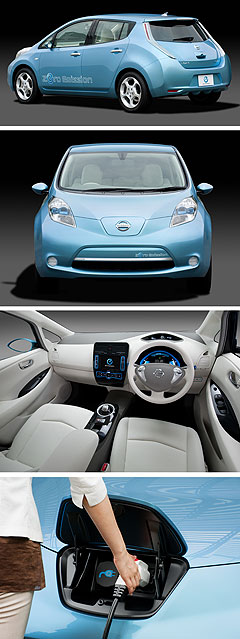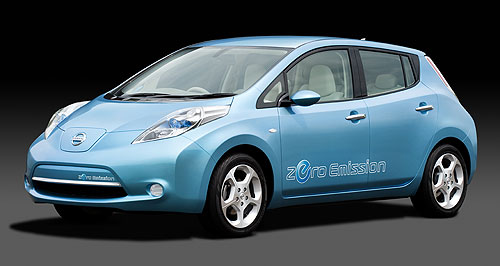Future models - Nissan - LeafFirst look: Nissan takes a Leaf out of EV bookLeaf sprouts: Nissan's new Leaf electric vehicle will have a range of 160km. Leaf electric vehicle heralds Nissan’s brave new world as the first in family of EVs3 Aug 2009 DO NOT let its garden-variety looks – or its even more ordinary name – deceive you, because Nissan’s all-new Leaf will be one of the most significant models ever produced by the Japanese car-maker, as well as the automotive industry as a whole. Launched as promised in Japan yesterday (August 2), the Leaf is expected to become the world’s first volume-selling all-electric vehicle when it goes on sale globally in 2010 and in Australia in 2012. The ground-breaking small five-door hatchback, which Nissan says seats five adults in comfort and has a real-world driving range of up to 160km, is officially described at the world’s first affordable, zero-emissions car. Of course, that overlooks the CO2 and other emissions produced during the car’s manufacture and eventual disposal or recycling (as with every vehicle), and the fact that as a pure electric vehicle (EV) the Leaf shifts CO2 emissions from its exhaust outlet to power stations, which in Australia continue to be fired predominantly by coal. But the production-ready Leaf marks a significant new direction from Toyota’s hybrid icon, the Prius, as well as General Motors’ Volt, which is also due on sale in the US in late 2010 and has been committed for sale (as a Holden) in Australia from 2012.  While the Volt features plug-in recharging technology, it is effectively a petrol-electric hybrid like the Prius, which has a token EV-only driving range and relies primarily on its battery-assisted petrol engine. While the Volt features plug-in recharging technology, it is effectively a petrol-electric hybrid like the Prius, which has a token EV-only driving range and relies primarily on its battery-assisted petrol engine.Described by GM as a range-extending EV, the Volt is driven exclusively by battery power, but incorporates a conventional CO2-emitting internal combustion to recharge its battery. Like the Leaf, the Volt has a claimed EV-only range of 160km. While both the fuel-efficient Prius and Volt can be driven indefinitely as long as they have fuel in their tanks, the Leaf relies entirely on battery power and therefore a network of proposed recharging and battery-swap stations, which is yet to be established in Australia. However, while the third-generation Prius has just been released in Australia priced from about $40,000 and the forthcoming Volt is expected to cost at least that much, Nissan Australia has previously targeted a sub-$30,000 starting price for its first EV. Yesterday the company said the Leaf would come to market with a price that is competitive with a well-equipped C-segment (small) vehicle, making it significantly cheaper than both the similarly-sized Prius and (four-seat) Volt five-door hatchbacks. However, that price doesn’t include the battery, which Nissan proposes will be leased to customers and has an anticipated life of just five years – less if it is not maintained at neat full capacity (above 80 per cent) during that period. Despite this, Nissan president and CEO Carlos Ghosn says the Leaf will be more affordable to own that an equivalent internal combustion vehicle, because the power that is required to recharge it will cost less than the petrol to fuel a conventional small car. US sportscar-maker Tesla has long produced all-electric plug-in vehicles with lithium-ion batteries, while Mitsubishi’s i-MiEV is the first EV to receive official Australia Design Rule approval. However, when supply frees up from the Japanese factory that produces the electric i-car, it is expected to cost about $50,000 here. At the heart of the Leaf lies what will be one of the world’s first mass-produced lithium-ion batteries. Similar to what will be employed by the Volt and also used in trials of a plug-in Prius, the Leaf’s Li-Ion battery pack is more powerful than a similarly-sized battery using traditional nickel-metal hydride technology, as in the production Prius. As with the Volt, the Leaf’s 48-module Li-Ion battery pack is integrated into the vehicle’s floorpan (in this case under it, in a separate frame), which Nissan says avoids cabin intrusion by the battery and reduces drag by contributing to smoother underfloor air-flow. The Leaf is built on a dedicated new EV platform that is claimed to be exceptionally quiet. It has a 24kWh laminated Li-Ion battery pack that generates a power output of more than 90kW, a “highly rigid” body and an electric motor that is rated at a competitive 80kW/280Nm. Nissan says the Leaf can be charged from empty to 80 per cent of its full capacity in less than 30 minutes with a 50kW “quick charger” or in less than eight hours at home using a 200-volt AC charger. That should be enough charge for 100km of travel, which it claims is enough to satisfy the requirements of most (presumably urban) drivers. According to Nissan, research shows the car’s total range of 160km meets the daily driving requirements of more than 70 per cent of the world’s consumers who drive cars. It says the Leaf, which goes on sale in Japan, Europe and the US in late 2010, is the culmination of decades of investment and research. “Nissan Leaf is a tremendous accomplishment – one in which all Nissan employees can take great pride,” said Mr Ghosn yesterday. “We have been working tirelessly to make this day a reality – the unveiling of a real-world car that has zero – not simply reduced – emissions. It’s the first step in what is sure to be an exciting journey – for people all over the world, for Nissan and for the industry.” The Leaf, which features regenerative braking technology, features a new bodyshell design that comprises an upright V-shaped front-end with elongated LED headlights that are claimed to consume just 10 per cent of the electricity of conventional headlights. Said to be closely related to the overall look of the next-generation Tiida, the ‘Aqua Globe’ body-coloured Leaf also features a bright and “environmentally friendly” interior colour scheme that extends to its blue instruments and dashboard highlights. Nissan says it will come with an exclusive information technology system that connects it to a global data centre to provide 24-hour support, information and entertainment. The Leaf dashboard features a monitor that displays the car’s remaining power or “reachable area”, as well as a selection of nearby charging stations. The car also has a “state-of-the-art” ability to use a mobile phone to turn on air-conditioning and set charging functions, even when Leaf is switched off, while an on-board remote-controlled timer can also be pre-programmed to recharge batteries. As previously reported, Nissan’s first EV will be produced at Nissan’s Oppama plant in Japan, with additional capacity planned for the Smyrna factory in the US. Nissan has received a near-$2 billion loan from the US Department of Energy to modify its Tennessee to produce EVs and their batteries from 2012. The Leaf’s Li-Ion batteries are being produced at Zama in Japan, with additional capacity planned for the UK and Portugal. Nissan says it is studying the investment in other battery production sites, with up to seven facilities each believed to have capacity to produce 50,000 batteries a year. That will be more than enough for the 200,000 examples of the Leaf Nissan is expected to produce annually from late 2010. According to Autocar, Nissan also plans to produce an all-electric version of Nissan’s upcoming Qazana mini-SUV and a production version of the Nuvu mini-EV by early next decade. However, Japan’s number-three car-maker, which has effectively skipped hybrid technology to go directly from conventional to electric vehicles, stresses it will continue to offer a range of separate emissions-reductions technologies, including continuously-variable transmissions (CVTs), idle-stop systems and clean diesels. It says fuel cell vehicles also remain in development. Displayed at the company’s new Yokohama headquarters for the first time yesterday, the Leaf measures 4445mm long, 1770mm wide and 1550mm high. It rides on a 2700mm wheelbase and its top speed is quoted at 140km/h.  Read more29th of May 2009  Nissan EV for rent in 2010Europcar to add Nissan’s new electric vehicle to hire fleet in Australia next yearAll future models Alfa Romeo Alfa Romeo Abarth Abarth Audi Audi Aston Martin Aston Martin BMW BMW Bentley Bentley Chrysler Chrysler Chevrolet Chevrolet Dodge Dodge Citroen Citroen Ferrari Ferrari DS DS Ford Ford Fiat Fiat FPV FPV Foton Foton Haval Haval Great Wall Great Wall Honda Honda Holden Holden Hyundai Hyundai HSV HSV Isuzu Isuzu Infiniti Infiniti Jeep Jeep Jaguar Jaguar Lamborghini Lamborghini Kia Kia Lexus Lexus Land Rover Land Rover Mazda Mazda Maserati Maserati Mercedes-Benz Mercedes-Benz McLaren McLaren Mini Mini Nissan Nissan Mitsubishi Mitsubishi Peugeot Peugeot Opel Opel Proton Proton Porsche Porsche Renault Renault Ram Ram Saab Saab Rolls-Royce Rolls-Royce Smart Smart Skoda Skoda Subaru Subaru SsangYong SsangYong Tesla Tesla Suzuki Suzuki Toyota Toyota Volvo VolvoMotor industry news |
Click to shareNissan modelsResearch Nissan All future models Alfa Romeo Alfa Romeo Abarth Abarth Audi Audi Aston Martin Aston Martin BMW BMW Bentley Bentley Chrysler Chrysler Chevrolet Chevrolet Dodge Dodge Citroen Citroen Ferrari Ferrari DS DS Ford Ford Fiat Fiat FPV FPV Foton Foton Haval Haval Great Wall Great Wall Honda Honda Holden Holden Hyundai Hyundai HSV HSV Isuzu Isuzu Infiniti Infiniti Jeep Jeep Jaguar Jaguar Lamborghini Lamborghini Kia Kia Lexus Lexus Land Rover Land Rover Mazda Mazda Maserati Maserati Mercedes-Benz Mercedes-Benz McLaren McLaren Mini Mini Nissan Nissan Mitsubishi Mitsubishi Peugeot Peugeot Opel Opel Proton Proton Porsche Porsche Renault Renault Ram Ram Saab Saab Rolls-Royce Rolls-Royce Smart Smart Skoda Skoda Subaru Subaru SsangYong SsangYong Tesla Tesla Suzuki Suzuki Toyota Toyota Volvo VolvoMotor industry news |
















Facebook Twitter Instagram